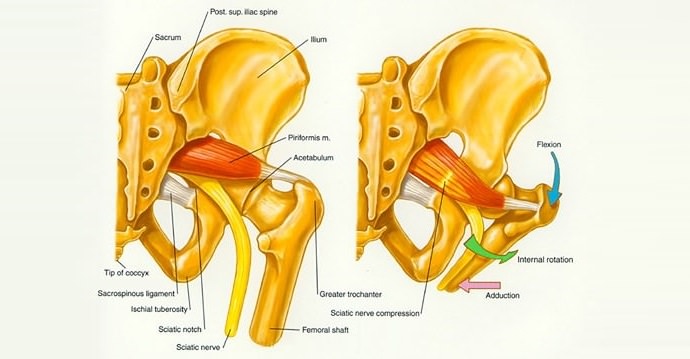Piriformis syndrome is a collection of symptoms that involve buttock pain, often with hip, groin or leg pain, and is found typically in people with mechanical lower back pain. It may mimic sciatica.
Anatomy of the Piriformis Muscle
The piriformis muscle is a small muscle in the pelvis that rotates the thigh outwards and moves it away from the body. The sciatic nerve runs through the pelvis and its relationship with the piriformis muscle varies. The sciatic nerve may be split into two portions or combined into one and this varies from person to person.
- The sciatic nerve may pass down in front of the piriformis muscle or…
- One part of the sciatic nerve passes through the muscle with another part passing in front of it or…
- One part runs above and behind the muscle, the other going down in front of it or…
- The whole sciatic nerve passes through the piriformis muscle on its route down towards the leg
Who Gets Piriformis Syndrome?
Piriformis syndrome may occur in 6-8% of people with lower back pain and is six times more common in women than men. It may be more common in long-distance bicycle riders, tennis players, skiers and lorry drivers.
What Causes Piriformis Syndrome?
It is not clear what causes this problem and no agreement on its cause exists. Suggestions have been trauma to the gluteal region and the sciatic nerve and abnormal pelvic mechanics in gait and sporting activity.
Piriformis Syndrome Symptoms
- Long-term buttock pain, worse on squatting down and walking
- Groin pain and pain on bowel movements
- Pain getting out of bed
- Limited sitting due to pain
Diagnosis of Piriformis Syndrome.
Piriformis syndrome is a diagnosis of exclusion, it’s what’s left when all other causes have been ruled out. This does not make it a very satisfactory diagnosis, but there are people who fit into the symptoms so it is worth considering in someone with long-term and/or thigh pain.
Tenderness over the buttock is the only real symptom, along with a lack of nerve changes and increased pain with a stretch of the muscle. Some researchers believe that a nerve stretch, lifting or a trauma to the region may be important factors.
Treatment for Piriformis Syndrome
Physiotherapy is the mainstay of treatment for this condition. Piriformis stretching, spinal manipulative techniques, local massage and muscle energy techniques are used to relax and mobilise the piriformis and its relationship with the nerve.
Exercises may be used to ease the pain before getting up, with cold packs and ultrasound also employed in treatment. The piriformis stretch should not be performed too forcefully as this may cause a worsening of the pain.
Injections of local anaesthetic into the trigger point in the piriformis muscle can be effective.
In rare cases, the piriformis tendon can be surgically cut or the sciatic nerve released from any surrounding adhesions. The results of these operations are reported to be good.
Over the long term, patients are advised to maintain a piriformis stretching programme and maintain flexibility and strength of the hip and pelvic region.
References:
- Cummings M. Piriformis Syndrome. BMJ 2000 VOL 18 (2) 108 http://aim.bmj.com/content/18/2/108.full.pdf
- Piriformis syndrome. Medscape. http://emedicine.medscape.com/article/87545-overview?
- Piriformis Syndrome. WebMD. http://www.webmd.boots.com/back-pain/guide/piriformis-syndrome
Last Review Date: 25-02-2020
Next Review Date: 25-02-2022

